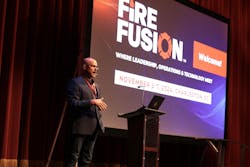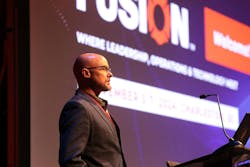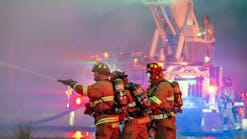FireFusion 2024: Artificial Intelligence Finds a Place in Emergency Responses
Technology is forever advancing, and with the emergence of artificial intelligence (AI), the changes in systems and applications can feel like a 90-degree turn every other second. However, Marcus Claycomb, business development manager at Panasonic Connect, preaches that public services can use these developments to their advantage.
"When the opportunity presents itself, you should absolutely open the door," said Claycomb during his "How Artificial Intelligence Can Be Used in Fire/Rescue and Public" address at FireFusion 2024. "Technology, when used correctly, is priceless and is something we should embrace."
Specifically, Claycomb presented multiple scenarios where AI can be used to the advantage of the first responders all across the board. From using voice-to-text when developing reports to traffic light preemption systems to layered thermal imagery, Claycomb said it outweighs the costs when it comes to implementing the technology into systems.
Before getting into the benefits, Claycomb presented what AI truly is, what the goal of utilization is and that there is a big misconception regarding actual 5G service. Most 5G service on cell phones is enhanced 4G service. Therefore, Claycomb made the comparison that working on an enhanced 4G server to a 5G server is like the difference of a garden hose at full boar as opposed to a five-inch line at full boar.
"You got to remember that AI is a transformer. It takes a little and transforms it into something, and then it holds that transform," said Claycomb.
First off, AI is intelligence exhibited by machines, and making sure that the AI being introduced applies to your services and needs is crucial to success and full return on investment with the new systems. Additionally, the voice of the customer needs to be heard during the entire process, and human oversight will be necessary in all elements. Claycomb emphasized that there are three main things when dealing with AI and the fire service: safety of your personnel, safety of the victims and efficient and effectiveness of operations. The primary function of implementing these new developments is to save lives, money and time.
"Once we embrace and understand what the benefits are, we need to make that known to the people that pay the taxes. They vote in the taxes to provide those resources and products to you," said Claycomb.
Benefits of AI that Claycomb outlined:
- Early warning system: This is a multi-faceted benefit. This provides citizens with a warning that emergency vehicles are enroute to a response, where they are coming from and where they are on the side of the road. There is a preventive measure against one of the most common accidents that happen to first responders, on the side of the road. This benefit, along with thermal imagery advances have been programs that Claycomb and Panasonic have worked on with NASA at the Jet Propulsion Laboratory.
- Data analysis: AI can help with data analysis by allowing the analysis to filter through information that would normally take them hours or days in minutes, freeing up more time for additional data analysis.
- Real-time factors: AI would help with first responders hearing the 911 call in real time, getting the layout of the building prior to being on scene, allowing for calls to be made before even arriving.
- Vehicle to everything (V2X): AI would allow for all vehicles to communicate with each other. This way your apparatus or recreation vehicle would be able to detect something four or five cars up and prevent the accident before it happens. Currently, Subaru is the only car company to do this with their vehicles, but are limited to just their own company. This would also allow for emergency vehicles to get out to areas where a high accident rate is detected or predicted enhanced by thermal imagery. The detail into is that the car or apparatus itself would be the hardware and that hardware is tied to the network, allowing for full access for AI to its best job.
- Text-to-voice: This one of the lower hanging fruits in the AI world in the public safety realm. Having workers use templates that AI produces, then tracks the conversation between the first responder and the patient and aids in filling out after-action reports. This is something that would need human oversight to correct any misinformation, but creates a sense of efficiency because the average person dictates four times faster than the average person can type.
- Streaming video feed: An implementation in play for some, streaming live video feed to the ER or trauma team to get immediate feedback while on scene treating a patient makes the process of transport and transfer more effective and efficient.
- Multi-layered vision: This is a benefit that would allow for the first responders to see all of their information from one source, layered over another. Meaning, they can the layout of the building, weak spots, where the response needs to be on scene and seeing people on the Z-axis (being able to see what floor they are on in a given structure).
Traffic light preemption:
- At the basic level, traffic light preemption is taking control over multiple traffic lights when responding to a call. AI takes CAD data, dispatch information, where the apparatus is and where they are going to flush out all the traffic to ensure the quickest past to the scene.
With benefits, there are always going to be cons to the whole idea. The biggest roadblock for most entities when attempting to implement AI is the cost. It is incredibly expensive. Then you add in, the learning curve that is prevalent between the older generation and the newer generation. The newer generation grew up with glimpses of this type of technology, meanwhile the older generation likes to work in their traditional ways. There's no blame to the older generation because it has and still does work for them. At the end of the day, it's about making things more efficient and effective.
Claycomb commented on the learning curve and how that can be minimized, "Through attrition of the dinosaurs, and I include me in that in that group. Luckily, I open my eyes, and I have embraced technology, but for those that didn't have it, they can't wrap their head around the exponential advances in technology in their lifetime. They're not open to it because they don't get it. No disrespect. For that group, the hurdle is, show them how it benefits, show them the added value. Sometimes that's easier than others," said Claycomb.
Another struggle that AI is running into is that they are attempting to be able to work from "the edge." Furthermore, AI is completely reliant on the cloud and connectivity to it. So, in more rural areas or where you wouldn't have the normal network connection, systems with AI tend to be stagnant. This is also plays into the cost effect, as AI requires a cellular wave that is more frequent, meaning more antennas.
Another factor that gets played into why AI is so expensive is that AI works on a different set of processors to make sure AI works as it should, called Graphic Processing Unit (GPU). Claycomb presented a great analogy of CPU (non-AI) versus GPU (AI). CPU is like a single paint gun, shooting one ball at a time to paint a smiley face, while GPU is a bank of paintball guns, all shooting at the same time to paint the Mona Lisa.
The AI system also needs to be on a closed circuit, closed off to the public sector or "sandboxed." The circuit needs to be secured and closed, and there were concerns sparked up during the keynote of the complications behind that regarding the security of the restricted date that first responders have access to.
"At the base level, you're trusting on the security of your IT group, sometimes more than others, with the IT department. Then, you are operating within a secure environment that's protecting all of that secure information and ensuring that the data you're using is data that you own and or as a trusted partner, so it'll never be on a perception point," said Claycomb.
Overall, it's incredibly difficult to implement AI into anything, let alone the implementation into public safety response is a complex issue. A complex issue that continues to turn around on a daily basis. Claycomb wants people to get on the train of AI being incorporated to enhance the overall success and efficiency of an incident respond, among other situations. The recommendation of determining your need, maximizing your budget and finding the right known source was made by Claycomb to those looking to start the process.

Ryan Baker
Ryan Baker is a writer and associate editor with prior experiences in online and print production. Ryan is an associate editor for T&D World and Firehouse, while he is going to graduate school in pursuit of a master's degree in sciences of communication at University of Wisconsin-Whitewater. He recently completed a year of teaching Intro to Public Speaking at UW-Whitewater, as part of his graduate program. Ryan acquired his bachelor's degree in journalism in 2023 from UW-Whitewater, and operates currently out of Minneapolis, MN. Baker, also writes freelances for the Ultimate Frisbee Association (UFA) in his free time, while also umpiring baseball for various ages across the Twin Cities Metro Area.








